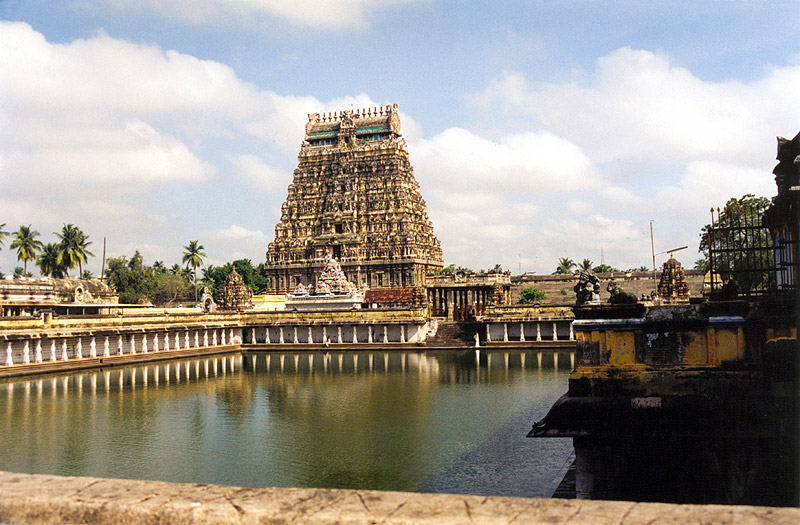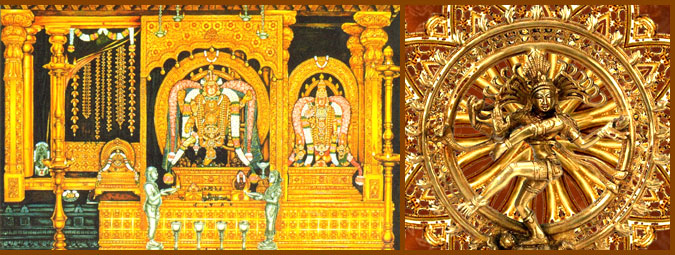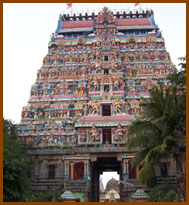Clik here to view.

See website of the templle: http://www.tillai.com/
CHIDAMBARAM NATARAJAR TEMPLE
October 1, 2012 by mahesh
Image may be NSFW.
Clik here to view.
 Natarajar Temple at Chidambaram is living testimony of ancient “Advanced astrological and geological knowledge” of Hindus surpassing to anything contemporary.
Natarajar Temple at Chidambaram is living testimony of ancient “Advanced astrological and geological knowledge” of Hindus surpassing to anything contemporary.STUNNING FEATURES OF ARCHITECTURAL EXCELLENCY:
The place where temple located is the center point of world’s magnetic equator.
Three of the five Panchaboothasthala temples, those at Kalahasti, Kanchipuram and Chidambaram all stand on a straight line exactly at 79 degree 41 minutes East longitude -truly an engineering, astrological and geographical wonder. Of the other two temples, Tiruvanaikkaval is located at around 3 degrees to the south and exactly 1 degree to the west of the northern tip of this divine axis, while Tiruvannamalai is around midway (1.5 degree to the south and 0.5 degree to the west).
The 9 gateways signify the 9 orifices in the human body.
The Chitsabai or Ponnambalam, the sanctum sanctorum represents the heart which is reached by a flight of 5 stairs called the Panchaatchara padi – pancha meaning 5, achhara – indestructible syllables – “SI VA YA NA MA”, from a raised anterior dias – the Kanakasabai. The access to the Sabhai is through the sides of the stage (and not from the front as in most temples). The Chit sabha roof is supported by four pillars symbolic of the four Vedas.
The Ponnambalam or the Sanctum sanctorum is held by 28 pillars – representing the 28 agama s or set methodologies for the worship of Shiva. The roof is held by a set of 64 beams representing the 64 forms of art and is held by several cross-beams representing the innumerable blood vessels. The roof has been laid by 21,600 golden tiles with the word SIVAYANAMA inscribed on them representing 21600 breaths. The golden tiles are fixed using 72,000 golden nails which represents the no. of nadis exists in human body. The roof is topped by a set of 9 sacred pots or kalasas, representing the 9 forms of energy. The arthamandapa (sanctum) has six pillars denoting the six shastras (holy texts).
The hall next to the artha mantapa has eighteen pillars symbolizing the eighteen Puranas.
Sri Nataraj Mandir at Satara is a replica of this temple.
http://mahaperiyavaa.wordpress.com/2012/10/01/architectural-marvel-of-chidambaram-natarajar-temple/
Uploaded on Jul 27, 2007
Om. Shri Shiva Nataraja dances His Cosmic Dance of Bliss in the great temple in Chidambaram. It is a treasury of history and all arts.
Most structures now part of the complex date to the period of the later kings of the Chola dynasty. According to the oral and textual tradition the origin of the temple goes back to at least 2500 years ago. For more information on the architectural history please visit my website www.earlychola.rajadeekshithar.com.
For more information on the traditions and the temple in general please read go to www.chidambaram.rajadeekshithar.com
Thanks for your interest. http://www.youtube.com/watch?v=uW-qrBQABD0
Image may be NSFW.
Clik here to view.

:: ABOUT THE TEMPLE ::
Chidambaram Temple is a Hindu temple dedicated to Lord Shiva located in the heart of the temple town of Chidambaram,Tamil Nadu).The temple , 78 km south of Pondicherry and 235 Km from Chennai, the capital of Tamil Nadu state of southeastern India. The Sangam classics refer to Viduvelvidugu Perumtaccan, respected clan of traditional Vishwakarmas, as being the chief architect of the temple renovation. There have been several renovations in its history, particularly during the days of Pallava/Chola emperors in ancient and pre-medieval periods.
Chidambaram is one of the five holiest Shiva temples, each representing one of the five natural elements; Chidambaram represents akasha (aether). The other four temples in this category are: Thiruvanaikaval Jambukeswara,Trichy (water), Kanchi Ekambareswara (earth)Kanchipuram, Thiruvannamalai Arunachaleswara (fire),Thiruvanna malai and Kalahasti Nathar (wind),Kalahasti
Image may be NSFW.
Clik here to view.

Temple
The temple complex spread over 50 acres in the heart of the city. It is an ancient and historic temple dedicated to Lord Shiva Nataraja and Lord Govindaraja Perumal, one of the few temples where both the Shaivite and Vaishnavite deities are enshrined in one place.To the followers of Shaivism (Saivism) or the saivaite, the very word koil refers to Chidambaram. In the same way, to the followers of Vaishnavism it refers to Srirangam or Thiruvarangam.
(Meaning of Chidambaram)
The word Chidambaram may be derived from chit, meaning "consciousness", and ambaram, meaning "sky" (from aakasam or aakayam); it refers to the chidaakasam, the sky of consciousness, which is the ultimate aim one should attain according to all the Vedas and scriptures.Another theory is that it is derived from chit + ambalam. Ambalam means a "stage" for performing arts. The chidakasam is the state of supreme bliss or aananda and Lord Natarajar is the symbolic representation of the supreme bliss or aananda natanam. Saivaites believe that a visit to Chidambaram leads to liberation.Yet another theory is that it is derived from the word chitrambalam, from chithu meaning "play or dances of God" and ambalam meaning "stage"
Special features
A unique feature of this temple is the bejeweled image of Nataraja. It depicts the Lord Shiva as the Lord of the dance Bharatanatyam and is one of the few temples where Shiva is represented by an anthropomorphic murthi rather than the classic, anionic Lingam. The Cosmic Dance of Lord Nataraja symbolises the motion of the universe as sustained by Lord Shiva. The temple has five courts.Aragalur Udaya Iraratevan Ponparappinan (alias Vanakovaraiyan) rebuilt the Siva temple at Chidambaram around 1213 AD. The same Bana Chief also built Tiruvannamalai temple.The temple has been traditionally administered by an endogamous group of shiavite brahmins called Dikshitar, who also officiate as its priest.
Temple Story
The story of Chidambaram begins with the legend of Lord Shiva strolling into the Thillai Vanam (Vanam meaning forest and thillai trees - botanical name Exocoeria agallocha, a species of mangrove trees - which currently grows in the Pichavaram wetlands near Chidambaram. The temple sculptures depicting the Thillai trees date back to the 2nd century CE).
In the Thillai forests resided a group of saints or 'rishis' who believed in the supremacy of magic and that God can be controlled by rituals and 'mantras' or magical words. The Lord strolls in the forest with resplendent beauty and brilliance, assuming the form of 'Pitchatanadar', a simple mendicant seeking alms. He is followed by his Grace and consort who is Lord Vishnu as Mohini. The rishis and their wives are enchanted by the brilliance and the beauty of the handsome mendicant and his consort.On seeing their womenfolk enchanted, the rishis get enraged and invoke scores of 'serpents' (Sanskrit: Nāga) by performing magical rituals. The Lord as the mendicant lifts the serpents and dons them as ornaments on his matted locks, neck and waist. Further enraged, the rishis invoke a fierce tiger, which the Lord skins and dons as a shawl around his waist.Thoroughly frustrated, the rishis gather all their spiritual strength and invoke a powerful demon Muyalakan - a symbol of complete arrogance and ignorance. The Lord wearing a gentle smile, steps on the demon's back, immobilizes him and performs the Ánanda Thaandava (the dance of eternal bliss) and discloses his true form. The rishis surrender, realizing that this Lord is the truth and he is beyond magic and rituals.
The Ananda Thaandava
Adhisesha, the serpent who serves as a bed for the Lord in his manifestation as Vishnu, hears about the Änanda thaandava and yearns to see and enjoy it. The Lord blesses him, beckons him to assume the saintly form of 'Patanjali' and sends him to the Thillai forest, informing him that he will display the dance in due course.Patanjali who meditated in the Himalayas during krita age joins another saint, Vyagrapathar / Pulikaalmuni (Vyagra / Puli meaning "Tiger" and patha / kaal meaning "feet" – referring to the story of how he sought and got the feet and eyesight of a tiger to help climb trees well before dawn to pick flowers for the Lord before the bees visit them). The story of sage Patanjali as well as his great student sage Upamanyu is narrated in both Vishnu Puranam as well as Siva Puranam. They move into the Thillai forest and worship Lord Shiva in the form of Shivalinga, a deity worshipped today as Thirumoolataneswarar (Thiru - sri, Moolatanam - primordial or in the nature of a foundation, Eswarar- the Lord). Legends say that Lord Shiva displayed his dance of bliss (the Aananda Thaandavam) - as Nataraja to these two saints on the day of the poosam star in the Tamil month of Thai (Jan – Feb).
Image may be NSFW.
Clik here to view.

The Ananda Tandava Posture
The Ananda Tandava posture of Lord Shiva is one of the famous postures recognized around the world by many. This celestial dancing posture tells us how a Bharathanatium Dancer should dance.
The demon under Nataraja's feet signifies that ignorance is under his feet
The Fire in this hand (power of destruction) means destroyer of evil
The raised hand signifies that he is the savior of all life.
The Ring at the back signifies the cosmos.
The drum in his hand signifies the origin of Life.
These are the main things that the Natarajar murti and the celestial dance posture depict. A rare type of thandava posture is seemed in Melakadambur temple near by 32 km from here.In this Karakoil, Nataraja dancing on a bull and deva's rounds the structure it's an pala art being kept in this shrine
Significance
Chidambaram is also referred to in various works such as Thillai (after the Thillai forest of yore in which the temple is now located), Perumpatrapuliyur or Vyagrapuram் (in honour of Saint Vyagrapathar).The temple is supposed to be located at the Lotus heart of the Universe": Virat hridaya padma sthalam. On the spot where the Lord displayed his dance of bliss, the Änanda Thaandavam - a spot exactly south of the "Thirumoolataaneswar temple", today is the Ponnambalam/ Porsabai (Pon meaning gold, Ambalam/Sabai meaning stage) housing the Lord Shiva in his dancing form. The Lord is also hence referred to as the Sabhanayakar, meaning the Lord of the Stage.
This gold-roofed stage is the sanctum sanctorum of the Chidambaram temple and houses the Lord in three forms:
the "form" - the anthromorphological form as an appearance of Lord Nataraja, called the Sakala thirumeni.
the "semi-form" – the semi-anthropomorphological form as the Crystal linga of Chandramouleswarar, the Sakala nishkala thirumeni.
the "formless" – as the Space in Chidambara Rahasyam, an empty space within the sanctum sanctorum, the Nishkala thirumeni.
Pancha Bootha Sthalas
Chidambaram is one of the Panchabootha Sthalas, where the Lord is worshipped in his manifestation as sky or Aagayam ("pancha" – meaning five, bootha – meaning the elements: earth, water, fire, wind and space and "sthala" meaning location).
The others are:
the Ekambareswarar temple at Kanchipuram, where the Lord is worshipped in his manifestation as Earth
the Jambukeswarar temple at Thiruvanaikaval, in Tiruchirapalli, where the Lord is worshipped in his manifestation as Water
the Annamalaiyar Temple at Tiruvannamalai, where the Lord is worshipped in his manifestation as Fire
the Kalahasti temple at Srikalahasthi, where the Lord is worshipped in his manifestation as air/wind.
Chidambaram also is one of the five places where Lord Shiva is said to have displayed his dance and all these places have stages/ sabhais . Apart from Chidambaram which has the Por sabhai, the others are the Rathina sabhai at Thiruvaalangadu (rathinam – ruby / red) , the Chitra sabhai at Courtallam (chitra – painting), the Rajatha sabhai or the Velli ambalam at Madurai Meenakshi Amman Temple (rajatha / velli – silver) and the Thaamira sabhai at Nellaiappar Temple, Tirunelveli (thaamiram – copper).
http://www.chidambaramnataraja.org/about_temple.html
Uttara Chidambaram Sri Nataraj Mandir – SATARA, Maharashtra
Image may be NSFW.
Clik here to view.
Satara is a town located in the Satara District of Maharashtra. The town gets its name from the Seven (Sat) Hills(Taras) surrounding it.
The Vyasa-puja of the year was performed at Satara on 27th of July, 1980. During His long camp at Satara, His Holiness Pujyasri Sri Chandrasekarendra Saraswathi Mahaswamiji desired that a temple for Sri Nataraja on the model of the ancient Nataraja temple at Chidambaram should be constructed at Satara. Samanna (late) an ardent devotee of the Acharya and a prominent citizen of Satara gifted away an adequate plot of land for building the temple.
The foundation for the temple was laid on an auspicious day in May 1981. Because of the grace of the Mahaswami, by the financial assistance of the then governments of the States of Maharashtra, Karnataka, Andhra Pradesh and Tamil Nadu, and the supply of the entire timber necessary for the construction by the government of Kerala and diverse kinds of aid by a number of philanthropists, a majestic temple of Sri Nataraja with gopurams (towers) over the four gateways, a replica of the original in Tamil Nadu, though much smaller in size, rose up in Satara in the course of about three years.
Image may be NSFW.
Clik here to view.
The Kumbabhishekam (consecration) of the new Uttara (North) Chidambaram temple was performed in the immediate presence of His Holiness Sri Jayendra Saraswati Swami, in 1984. It is worthy of note that His Holiness caused to get funds raised for daily worship at the temple, which is being performed by Dikshitas of the Chidambaram temple, going over to Satara by rotation, according to the desire of the Acharya.
In addition to the presiding deity, other Shrines located in the temple include:
Ganapati Mandir(Lord Ganesha's Temple)
Hanumaan Mandir (Lord Maruti/Hanumaan's Temple)
Raadha-Krishna Mandir (The Temple of Lord Krishna & Goddess Raadha)
Shiva Linga Mandir (The Temple of Lord Shiva's 'Linga')
Nav-Graha Mandir (The Temple of Nine Devine Planets)
Aadya Shankaracharya Mandir (The Temple of Aadya Shankaracharya)
Ayyappa Swami Mandir(Lord Ayyappa's Temple
The temple is located just off the National Highway NH4 connecting Satara and Solapur. A veda Patasala is also being run by Sri Kanchi Kamakoti Peetam at the temple.
Image may be NSFW.
Clik here to view.
Distance to Satara From :
Sangli- 110 kms
Kolhapur – 128 kms
Pune – 110 kms
Mumbai – 260 kms
Reaching Satara:
By Road - NH4 highway : MSRTC runs intercity bus service from Mumbai, Pune, Sangli-Miraj and Kolhapur to Satara.
By Rail - Satara Railway Station. Satara is connected to Ahmedabad, Bangalore, Mysore, Baroda, Surat, Delhi, Mumbai, Pune, Nagpur, Sangli-Miraj and Goa by express trains.
For more info., contact
Shri P.Jagadeesh Bhat
Shri Uttara Chidambaram Nataraja Mandir, Satara
Krishna Nagar, Satara - 415003
Maharashtra State
email:natarajasatara@gmail.com
Mob. 9404909000/ 94231 44888
Off. 02162 - 244254
http://www.kamakoti.org/kamakoti/details/Uttara%20Chidambaram.html
Image may be NSFW.
Clik here to view.

http://www.natarajasatara.org/
http://www.natarajasatara.org/photo-galry.html